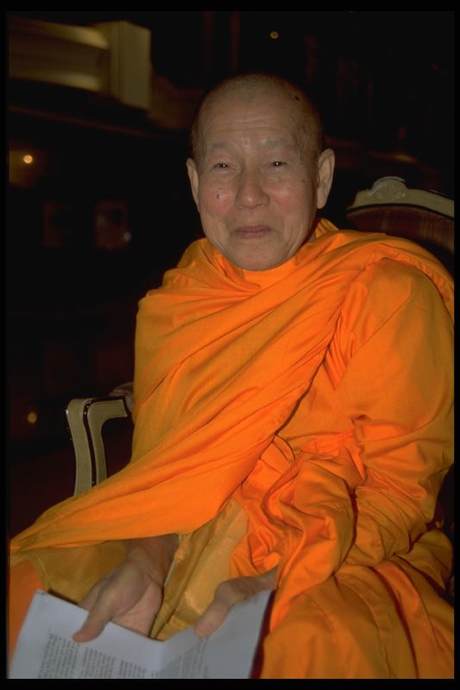The Venerable Maha Ghosananda hands out books on wise leadership. Behind him is a painting of Finger-garland - a figure from Buddhist scripture - who killed scores of villagers, cut their fingers off and wore them around his neck. The relevance of this story to the Khmer Rouge is that Finger-garland not only repented, but went through the villages he had terrorized spreading a message of harmlessness. Villagers pelted him with sticks and pots, but the Buddha advised him, 'Bear it, bear it. You are experiencing here and now the result of deeds for which you might have been tortured in hell for thousands of years.'
Finger-garland himself exclaimed: 'There are some who tame with beatings, some with goads and some with whips; but I was tamed by such alone who has no weapon.'
The Khmer Rouge perpetrated one of the most drastic political experiments in human history. In an attempt to return Cambodia to 'Year Zero', and to create a society cleansed of all foreign and feudal influence, they exterminated more than one million people. Every member of the Khmer Rouge politburo that ruled Cambodia between 1975 and 1979 is implicated in genocide. All of them have eluded trial.
From bases in heavily-mined, forested tracts of north and west Cambodia, the Khmer Rouge has continued to fight the government in Phnom Penh for almost 20 years. Throughout that time they have remained secretive and utterly opaque to foreign scrutiny.
But last year that changed. The guerrilla movement split down the middle and thousands of its troops and families defected to the Royal Cambodian Armed Forces. Pol Pot and a hard core of guerrillas still hold out in a jungle enclave, but their influence on the future of the country looks more and more irrelevant. The question facing Cambodia today is: How do you deal with the remnants of a regime which turned the country into the killing fields and now says 'We have defected'?
There is surprising unanimity amongst ordinary people on one aspect of this question. They will tell you that lower-ranking Khmer Rouge soldiers and their families should be pardoned and re-integrated into normal society. However, there is significant disagreement on what fate should befall Pol Pot's close associates and commanders.
Amidst the secret deals, the pay-offs, the intimidation and the controversy, the path of Buddhism beckons Cambodians away from conflict and despair towards compassion and equanimity. This is the spiritual heritage of 95 per cent of Cambodians. The Khmer Rouge attempted to obliterate it, and failed.
Supreme Patriarch Maha Ghosananda, who lost his entire family during the Pol Pot regime, exemplifies the Buddhist path in contemporary Cambodia. Earlier this year he led a three-week long peace march through all the former strongholds of the defecting Khmer Rouge units. Travelling through some of the most heavily mined territory in the world, he and his fellow monks and nuns offered their message to throngs of villagers: 'We must remove the landmines in our hearts which prevent us from making peace -greed, hatred and delusion. We can overcome greed with the weapon of generosity; we can overcome hatred with the weapon of loving kindness; we can overcome delusion with the weapon of wisdom. Peace-making starts with us.'
English


